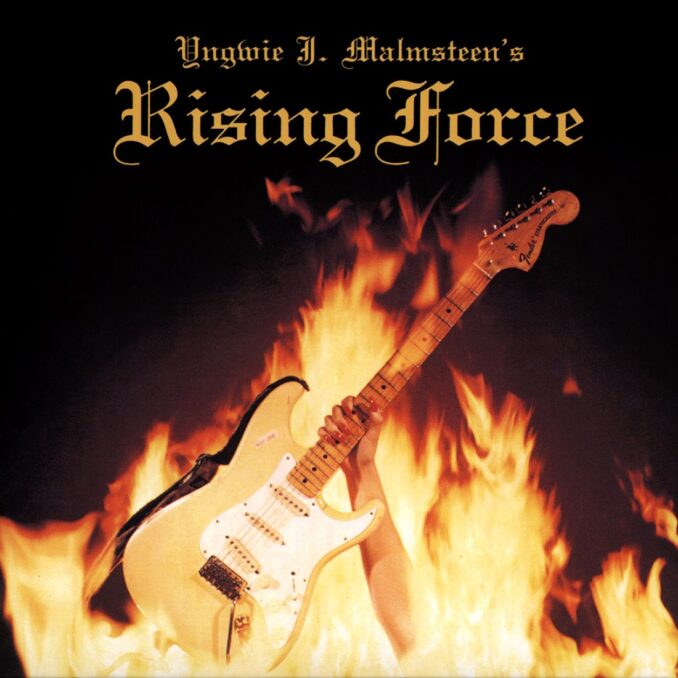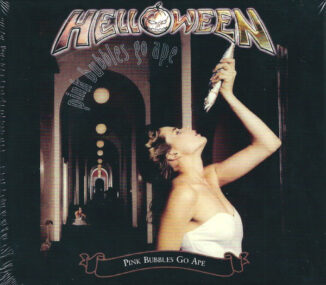
Summary
Polydor Records
Release date: March 5, 1984
User Review
( votes)Heavy Metal was in full swing in 1984, and the record labels were in love with the music. As glamour metal (hair bands) began to surface, the anti-hair band concept was also born: more specifically, a guitarist who relied solely on his own musical talents and creativity, desiring to burn what was essentially an all-instrumental Heavy Metal album. The Polydor label took a huge plunge when it signed Malmsteen…however; others in the music industry were intrigued by the all-instrumental Heavy Metal concept and were watching closely.
In the United States (my only perspective, you know), when this album hit the record stores, interest immediately began brewing about a new guitarist who was billing himself out to be “better than Eddie Van Halen”. Could it be true? “Well, let’s at least give it a listen,” was often the consensus response…and obviously the right decision in retrospect!
Malmsteen got his opportunity and made the most of it with this release. His fret board speed, coupled with creative acoustic/electric guitar mixes, driving bass rhythms, and curious use of electronic keyboards made this album an instant classic…and opened the door for others in the Heavy Metal genre who also had the idea that all-instrumental albums would be well received by the fan base. Guitarists such as Joe Satriani and Eric Johnson owe plenty to Malmsteen for forging ahead and setting the stage for their ultimate ease of acceptance, promotion, and success. We, as fans, simply benefit from a truly well written, skillfully presented piece of Heavy Metal musical art.
The album begins with the track “Black Star”, which opens with a stringed symphony-ish guitar passage and mood-setting bass riff. The percussion is smooth and consistent; the methodical bass drum beat rounds out the full spectrum of the Malmsteen sound. “Black Star” beautifully keeps the deliberately steady beat amid Malmsteen vacillating from blistering speed to thoughtfully slow guitar interludes. The percussion cymbals and snare, however, are noticeably underemphasized and almost sound as if they are being hit by brushes vs. sticks…possibly done in a concerted effort to “not get in the way” of Malmsteen’s guitar clarity? If so, who can blame Malmsteen, however, the overall sound of the album would have benefited from a tad bit more high-end drum enhancement.
The second track, “Far Beyond the Sun”, features impressive keyboard work to illicit an eerie evil and spooky flair to the song. The track also features a keyboard solo that is paired up and challenged with the task of keeping pace with Malmsteen’s solo – a tough requirement, however, a nice complement to a well-composed song. If you’ve never listened to Malmsteen before, by the end of this song, you can’t help but to be thoroughly impressed with Malmsteen’s effortless speed, clarity, and smooth delivery…truly something special.
Malmsteen takes a crack at writing a conventional song WITH LYRICS in the third track, “Now Your Ships Are Burned”. Musically, the song is as good as any of them on the album, but unfortunately the song ends up being a failure (read on for my reasoning), and is the solitary reason the Overall Rating for this album is an “A-“ instead of a solid “A”. There is nothing wrong with Jeff Scott Soto’s voice or vocal quality, but the lyrical pattern is overly concentrated on forcing a rhyme scheme at the expense of allowing the words to flow smoothly…causing a choppy presentation at best. Additionally, Malmsteen doesn’t let his guitar take a back seat to vocals when Soto is singing. Instead, Malmsteen plays the same notes as those being sung by Soto, making you wonder whether or not Malmsteen really wrote this song with the intent of lyrics being included – including lyrics may indeed have been an after thought. In the end, the lyrics simply get in the way of an otherwise solid musical track. Conversely, the only other song with lyrics on the album, the sixth track “As Above, So Below”, is much more successful at integrating the lyrics into the framework of the song, therefore allowing Soto’s talents to become much more evident. Along with less emphasis on forcing a rhyme scheme, the main difference in this track compared to “Now Your Ships Are Burned” is that Malmsteen does in fact subdue his guitar playing and settles for a back seat rhythmic chord pattern to allow the listener to soak in and focus on Soto’s vocals. Of course, Malmsteen still takes the opportunity to allow his playing to shine when the lyrical passages rest.
“Evil Eye” is the fourth track and features a magnificent acoustical intro and acoustical pair-up with the electric guitar. In my opinion, Malmsteen did this to fully show the spectrum of his skills…to eliminate the possibility of any critic stating that his playing skills and speed can’t be fully evaluated since he “hides” behind the typical distortion of a Heavy Metal guitar player. Clearly, no matter what the axe, Malmsteen demonstrates he has full command of the instrument. Listening to this track, you’ll notice Malmsteen completely shifts gears about 4 times, sort of creating a medley of shorter songs into one. Each shift, however, is well conceived and completely entertaining.
My favorite song is the fifth track, “Icarus’ Dream Suite”. The song starts with a slow, almost sad beginning that causes the listener to visualize a classic Shakespearean romance in the Medieval morning dew…..sigh…..In time, about half way through, the song introduces a solid “chomping” bass riff to let us remember that indeed this is still a Metal album.
The seventh track, “Little Savage” is a bass driven gem. Malmsteen plays all of the bass guitars too in this album, by the way. Not only in this song, but also throughout the album, the percussion bass and bass guitar work probably don’t get as much credit as they deserve. Within each song, Malmsteen does a remarkable job of establishing a foundation-setting bass layer that fosters a solid backbone within each song, setting the stage for his cutting edge guitar playing to shine through. Towards the end of “Little Savage”, Malmsteen characteristically shifts gears again into a completely different groove…one that I wish would have been longer, or perhaps segregated and lengthened into its own separate song. It simply rocks.
Malmsteen ends this album with a very short track entitled “Farewell”…a soft-spoken guitar-only song. Nothing new in this one, essentially just a short fade-out song with the intent of “settling down” the listener, who by this time is probably catching flies due to their mouth being wide open in awe for so long!
Overall, Yngwie J. Malmsteen’s Rising Force was just that, a rising force. Clearly establishing himself as “a” or “the” guitarist composer and player extraordinaire, Malmsteen delivered a true “treat” to the musical industry and the Heavy Metal world. Malmsteen’s inspiration showed the critics that the Heavy Metal genre does in fact possess some of the world’s most accomplished and talented musicians.
Guitars & Bass: A+
Percussion: B+
Vocals: B
Lyrics: D+
Recording Quality: A
Originality: A
Overall Rating: A-
Originally Released: 1984




Be the first to comment